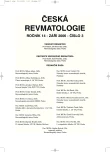Issue of tuberculosis associated with TNF blocking treatment in the Czech Republic
Authors:
D. Tegzová; K. Pavelka; K. Jarošová; P. Horák; P. Vítek; P. Bradna; L. Bortlík; J. Vencovský
Authors‘ workplace:
Revmatologický ústav, Praha
Published in:
Čes. Revmatol., 14, 2006, No. 3, p. 126-134.
Category:
Original Papers
Overview
The most serious side effect of TNF blocking therapy is tuberculosis (TB), particularly, reactivation of latent form of TB. TNF alpha is a pro-inflammatory cytokine with an important physiological role in the organism. Its chronic blockade may result in negative side effects. After initial TB infection, the majority of adults develop protective immune response to mycobacterium tuberculosis. However, this response is unable to eradicate all the bacilli, and these may persist in condition of low metabolic activity for a long time. When cell-mediated immunity is altered, disease reactivation may occur even decades after primary infection. Basic mechanism of the defense against TB is granuloma formation. TNF alpha has significant role in granuloma onset as well as its persistence. Inhibition of TNF alpha may cause granuloma disintegration, and thereby potential reactivation of the infection. Anti-TNF treatment has been found to be associated with four times increased incidence of TB infection compared to general population. Differences occur in its course: there is much higher incidence of extra-pulmonar TB, disseminated form of TB as well as higher mortality. Reactivation of latent TB usually occurs during the first three months of TNF blocking treatment. In the Czech Republic, six subjects have suffered from TB infection during anti TNF treatment so far. All of them started anti-TNF treatment before screening for latent TB has been initiated, which included obligatory tuberculin test and chest X-ray. All six patients had particularly long history of immunosuppressive treatment and concomitant administration of methotrexate. The median of TB onset was 17 months. Eighty-three percent of patients had pulmonary TB. Mortality was high – 50%. The diagnosis of TB was not straightforward and it took a long time to reach it in all cases. The detection of TB infection using cultures was negative almost in all the patients and definitive diagnosis was finally determined by histology. High occurrence of TB infection due to anti-TNF treatment led to the introduction of more strict control for all the patients whom such a treatment is considered. These preventions significantly decreased frequency of TB cases. Individual countries have worked out local guidelines for TB prevention that arise from the international consensus on biological treatment and safety policy.
Key words:
rheumatoid arthritis, TNF blocking treatment, tuberculosis, latent tuberculosis
Labels
Dermatology & STDs Paediatric rheumatology RheumatologyArticle was published in
Czech Rheumatology

2006 Issue 3
Most read in this issue
- Affection of temporomandibular joint in rheumatic diseases
- Rheumatic and other manifestations of Campylobacter jejuni infection
- Issue of tuberculosis associated with TNF blocking treatment in the Czech Republic
- Pulmonary manifestations in selected systemic rheumatic diseases registered in the Czech Clinical Database/Registry
